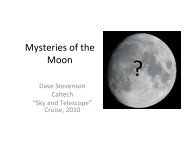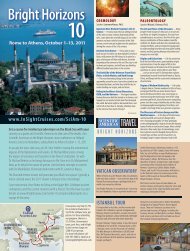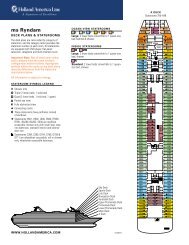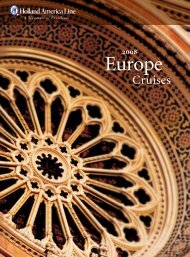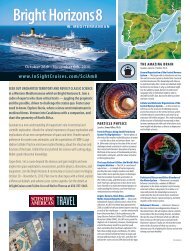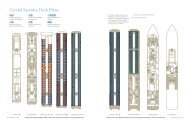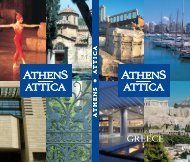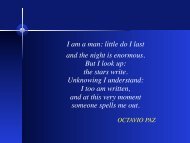Croatian cultural heritage - Business - Hrvatska turistiÄka zajednica
Croatian cultural heritage - Business - Hrvatska turistiÄka zajednica
Croatian cultural heritage - Business - Hrvatska turistiÄka zajednica
Create successful ePaper yourself
Turn your PDF publications into a flip-book with our unique Google optimized e-Paper software.
42<br />
Split only became the capital of Dalmatia after World War<br />
I, when the former capital city of Zadar came under temporary<br />
Italian rule. The centre of Dalmatia in the Antique<br />
Period was Salona, whose ruins are located near the city<br />
of Split, in today's Solin. THE ANTIQUE SALONA was a<br />
metropolis of the great Roman province of Dalmatia, which<br />
then spread across an area on the east coast of the Adriatic<br />
and was greater than the whole of Croatia today.<br />
The extensive ruins of Salona speak of its importance (42),<br />
which often surprises visitors (37) with respect to its location<br />
in the mainly industrial suburb of Split. Sometimes you<br />
can see the whole layout of individual buildings (30) and<br />
preserved Roman arches of the former palace (35), but most<br />
of the findings from Salona are stored in the most valuable<br />
museum of Split - the Archaeological Museum, the oldest<br />
<strong>Croatian</strong> Museum, founded in 1820.<br />
The building of the museum boasts an interesting atrium<br />
(40), and a nicely decorated interior (36), with about 150 000<br />
different exhibits. Apart from the sites of Salona and other<br />
Roman sites, there are many objects from ancient Greece<br />
(33) and the early medieval period. Among the exhibits is<br />
the collection of antique sarcophagi (31 & 34), stone plastic<br />
(32 & 38), antique clay lamps and Roman glass (29 & 41),<br />
bone and metal objects (39) and precious stones.<br />
Along the coast of the Kaštela Gulf, where the Antique Salona<br />
and Split are, is another great pearl of <strong>Croatian</strong> <strong>cultural</strong><br />
<strong>heritage</strong> which is protected as a World Heritage Site by<br />
UNESCO – THE HISTORIC CITY OF TROGIR. Located<br />
on a small island between the mainland and the island of<br />
Čiovo, which it is connected to by bridges, the city has kept<br />
its appearance almost unchanged since the Middle Ages<br />
(43). Trogir is particular for the continuity of its existence<br />
since Ancient Greek times, and there we can find, one next<br />
to another, monuments from the Hellenistic period, Ancient<br />
Rome, the early Middle Ages and late Middle Ages.<br />
The most important <strong>cultural</strong> monument in Trogir is the<br />
Cathedral of St. Lawrence, built from the 13th to the 15th<br />
century. It is known for its impressive Romanesque portal,<br />
which was sculpted by perhaps the best, as the inscription<br />
says, master sculptor, Radovan (47), and for the altar with<br />
a monumental ciborium (54). The chapel of Blessed John<br />
Ursinij was built in the northern nave of the church in the<br />
15th century (49) and its magnificent sculptures on the<br />
walls and ceiling (57) are considered to be the apex of Renaissance<br />
architecture and sculpture in Dalmatia, in which<br />
Nikola Firentinac, Andrija Aleši and Ivan Duknović have<br />
left their work. Next to the cathedral is the City Lodge from<br />
the 15th century (56), and from the same time originates<br />
the tower Kamerlengo (55) at the west end of town, which is<br />
sung about in many melodious Trogiran songs.<br />
The largest part of the findings from the rich history of<br />
Trogir is contained in the Museum of Trogir, in the Palace<br />
Garagnin - Fanfogna. The museum treasures valuable paintings<br />
(45 & 46) and sculptures (52), and has a richly equipped<br />
library (44). The 11th century female Benedictine Monastery<br />
of Saint Nicholas (50) also holds a valuable collection.<br />
101



